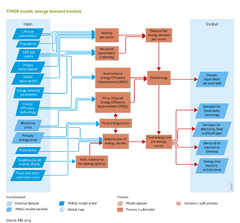Energy demand/Data uncertainties limitations: Difference between revisions
Jump to navigation
Jump to search
No edit summary |
No edit summary |
||
| Line 1: | Line 1: | ||
{{ComponentDataUncertaintyAndLimitationsTemplate | {{ComponentDataUncertaintyAndLimitationsTemplate | ||
|Reference=van Ruijven et al., 2010a; van Ruijven et al., 2010b | |Reference=van Ruijven et al., 2010a; van Ruijven et al., 2010b; Van Vuuren et al., 2008; | ||
|Description=<h2>Data</h2> | |Description=<h2>Data</h2> | ||
The energy demand module has been calibrated for the 1971–2007 period in order to reproduce historical trends in fuel and electricity use (see papers on individual model components, such as [[Van Ruijven et al., 2010a]]). Using the historical input data on population and value added and the calculated energy prices as given, other drivers and model parameters were varied systematically within the range of values derived from the literature, in order to improve the fit ([[Van Ruijven et al., 2010a]]; [[Van Ruijven et al., 2010b]]). | The energy demand module has been calibrated for the 1971–2007 period in order to reproduce historical trends in fuel and electricity use (see papers on individual model components, such as [[Van Ruijven et al., 2010a]]). Using the historical input data on population and value added and the calculated energy prices as given, other drivers and model parameters were varied systematically within the range of values derived from the literature, in order to improve the fit ([[Van Ruijven et al., 2010a]]; [[Van Ruijven et al., 2010b]]). | ||
Revision as of 12:16, 5 May 2014
Parts of Energy demand/Data uncertainties limitations
| Component is implemented in: |
|
| Related IMAGE components |
| Projects/Applications |
| Key publications |
| References |
